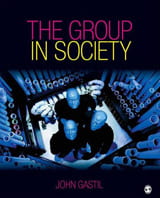

About this Book
Early praise for The Group in Society
“Small groups are stubbornly interdisciplinary; it’s a blessing and curse. Groups remain endlessly fascinating and attract attention from as wide a set of disciplines as any single subject out there. But this interdisciplinarity also creates fractures that, at worst, paralyze advances in the field. The conventional wisdom has been to create a unified theory—identifying the same member roles, stages of development, and elements of cohesion—that applies equally to all groups regardless of their function and environmental context. Instead, in this thoughtful and expansive new book, Gastil artfully weaves together case studies, theory, and empirical analysis to propose that we should think of, and apply, group archetypes—families, teams, juries—to help us highlight the predictable differences among types of groups. From this vantage point, modern groups such as terrorist cells and facebook, as well as the “standards” such as group therapy and work groups, are all better understood. Any student of small groups will learn from this book. George Homans said over half a century ago that small groups were at the very center of our lives as human beings; they are the foundation of society. The Group in Society couldn’t make this point any better.”
Aaron Brower, University of Wisconsin-Madison
“In the sea of group communication textbooks, this one stands out as a winner! It successfully integrates scholarship from various fields and approaches with examples from natural and popular groups. The result is an engaging and theoretically-rich exposition of the most important group phenomena. This textbook would be a wonderful addition to any course on groups.”
Gwen Wittenbaum, Michigan State University
“The Group in Society covers the literature of the last 50+ years by providing a sample of research (640 or so references drawn from a body of research that numbers in the tens of thousands.) However the main contribution of the book is to summarize, in the form of diagrams, the major variables that are covered in each chapter in an ’embedded system,’ noting the additional relationships and variables that are documented. Thus theory is placed ‘up front’ and can be elaborated as one learns more about the relationship between the group and society.”
A. Paul Hare, Ben-Gurion University, Israel
“The Group in Society is an important, unique and engaging overview of groups and group research that balances discussion of theory and research with historical, critical, critical, practical, and pedagogical issues. The book is interdisciplinary in its approach, but is of particular value to communication researchers and students, who will find the emphasis on interaction, decision-making, affiliative issues particularly attractive.”
Joe Bonito, University of Arizona
“Offering vivid examples of real-life groups, and the theories, structures, and systems that explain them, The Group in Society shows us that understanding groups matters in vitally important ways for our social lives. Readers who complete this book will walk away with a firm grasp of the complex group-oriented world in which we all live, and will hopefully be inspired to make sure that all groups they encounter matter.”
Renee A. Meyers, University of Wisconsin-Milwaukee
“The Group in Society is an important book that offers an original perspective about how groups are embedded in larger contexts to debunk common misunderstandings about groups and to show what actually occurs in a wide range of real-life groups, from families to peer groups to work teams to civic groups. Weaving together research findings, case studies, and a wealth of other information, Gastil reveals how groups are the cornerstone of society and affect everyone’s life, helping readers not only to become better group members but also better citizens.”
Lawrence R. Frey, University of Colorado at Boulder